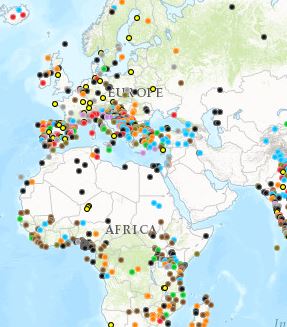EJAtlas
The Environmental Justice Atlas documents and catalogues social conflict around environmental issues. To go straight to the EJAtlas, click here.
Across the world communities are struggling to defend their land, air, water, forests and their livelihoods from damaging projects and extractive activities with heavy environmental and social impacts: mining, dams, tree plantations, fracking, gas flaring, incinerators, etc. As resources needed to fuel our economy move through the commodity chain from extraction, processing and disposal, at each stage environmental impacts are externalized onto the most marginalized populations. Often this all takes place far from the eyes of concerned citizens or consumers of the end-products.
The EJ Atlas collects these stories of communities struggling for environmental justice from around the world. It aims to make these mobilization more visible, highlight claims and testimonies and to make the case for true corporate and state accountability for the injustices inflicted through their activities. It also attempts to serve as a virtual space for those working on EJ issues to get information, find other groups working on related issues, and increase the visibility of environmental conflicts.
The Atlas is directed at ICTA-UAB by Leah Temper and Joan Martinez Alier and coordinated by Daniela Del Bene, at the Institute of Environmental Science and Technology (ICTA) at the Universitat Autonoma de Barcelona. It is supported by the ENVJUSTICE project (ERC Advanced Grant 2016-2021), and the ACKnowl-EJ (Academic-Activist Co-Production of Knowledge for Environmental Justice, 2015-2018) funded by the Transformations to Sustainability Programme.
Find out more here:
This data set is made available under the terms of the Creative Commons Attribution-NonCommercial-ShareAlike 3.0 Unported license. You are free use the work for noncommercial purposes only, with attribution given to the EJatlas and a link to this page. Resulting work must be distributed under the same license or one similar. If you wish to use the data for academic publications please cite as follows:
- Leah Temper, Daniela del Bene and Joan Martinez-Alier. 2015. Mapping the frontiers and front lines of global environmental justice: the EJAtlas. Journal of Political Ecology 22: 255-278.
You may find the full article explaining the methodology and aims of the atlas here: http://jpe.library.arizona.edu/volume_22/Temper.pdf
On this link (http://ejatlas.org/about) you can find out
- how an ecological conflict is defined
- what the drivers of these conflicts are
- what environmental justice is
- what types of information you can find in the Atlas
- how we map
- how you can use the Atlas
- how the platform is made
- how you can get involved


The project ENVJUSTICE has received funding from the European Research Council (ERC) under the European Union’s Horizon 2020 research and innovation programme (grant agreement No. 695446)